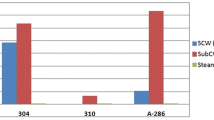Abstract
Corrosion of SAE 310 stainless steel in H2-H2O-H2S gas mixtures was studied at a constant temperature of 1150 K. Reactive gas mixtures were chosen to yield a constant oxygen potential of approximately 6 × 10-13 Nm-2 and sulfur potentials ranging from 0.19 × 10-2 Nm-2 to 33 × 10-2 Nm-2. The kinetics of corrosion were determined using a thermobalance, and the scales were analyzed using metallography, scanning electron microscopy, and energy dispersive X-ray analysis. Two corrosion regimes, which were dependent on sulfur potential, were identified. At high sulfur potentials (P S 2 ± 2.7 × 10-2 Nm-2) the corrosion rates were high, the kinetics obeyed a linear rate equation, and the scales consisted mainly of sulfide phases similar to those observed from pure sulfidation. At low sulfur potentials (P S 2 ± 0.19 × 10-2 Nm-2) the corrosion rates were low, the kinetics obeyed a parabolic rate equation, and scales consisted mainly of oxide phases. Thermochemical diagrams for the Fe-Cr-S-O, Fe-Ni-S-O, Cr-Ni-S-O, and Si-Cr-S-O systems were constructed, and the experimental results are discussed in relation to these diagrams. Based on this comparison, reasonable corrosion mechanisms were developed. At high sulfur potentials, oxide and sulfide phases initially nucleate as separate islands. Overgrowth of the oxide by the sulfide occurs and an exchange reaction governs the corrosion process. Preoxidation at low oxygen potentials and 1150 K is beneficial in suppressing sulfidation at high sulfur potentials.
Similar content being viewed by others
References
D. B. Rao and H. G. Nelson: (NASA Technical Memorandum 73,116, 1976),Proc. Symposium on Properties of High Temperature Alloys, Electrochemical Soc., Princeton, NJ, 1977, vol. 77-1, 2A, pp. 464–92.
D. B. Rao and H. G. Nelson: (NASA Technical Memorandum 73,246, 1977),Oxidation of Metals, 1978, vol. 12, pp. 111–38.
K. T. Jacob, D. B. Rao, and H. G. Nelson: (NASA Technical Memorandum 78,465, 1977),Oxidation of Metals, 1979, vol. 13, pp. 25–55.
JANAF Thermochemical Tables, NSRDS-NBS 37, 1974.
J. Bernard, J. Hertz, Y. Jeannin, and J. Moreau:C. R. Acad. Sci. Ser. A, 1959, vol. 248, p. 2095.
K. T. Jacob and C. B. Alcock:Metall. Trans. B, 1975, vol. 6B, pp. 215–21.
Author information
Authors and Affiliations
Additional information
Formerly a Senior Scientist with Materials and Molecular Research Division, Lawrence Berkeley Laboratory, Berkeley, CA 94720.
Rights and permissions
About this article
Cite this article
Rao, D.B., Jacob, K.T. & Nelson, H.G. Corrosion of 310 stainless steel in H2- H2O- H2S gas mixtures: Studies at constant temperature and fixed oxygen potential. Metall Trans A 14, 295–305 (1983). https://doi.org/10.1007/BF02651626
Received:
Issue Date:
DOI: https://doi.org/10.1007/BF02651626




